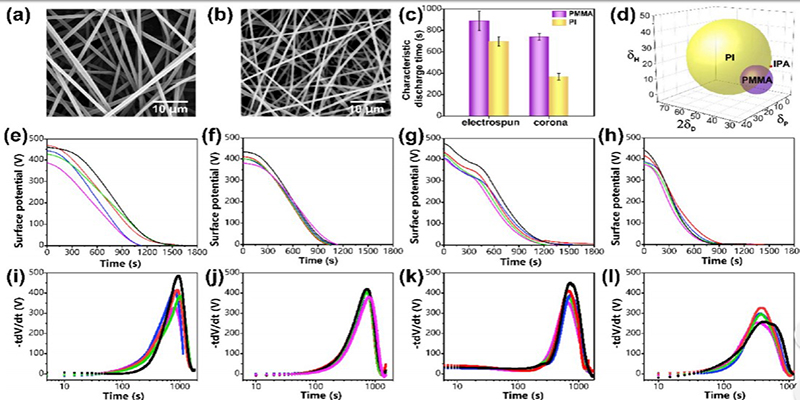© Copyright 2020 Foshan Membrane Technology Co., Ltd. All rights reserved. Sitemap
Due to recent serious air pollution especially in Asian countries, electret air filters with ultra-high efficiency have attracted much attention. However, the crucial issue of restraining charge dissipation to maintain stable electrostatic capture efficiency is still challenging. Herein, electret mechanisms, charge degradation kinetics and lifetime in filtration applications of electrospun membranes and corona-charged membranes exposed to isopropanol vapor and high humidity were studied. The surface potential degradation was measured in an in-situ discharging and monitoring setup. Electrospun membranes have longer charge retention time compared to corona-charged membranes. A dual-level trap model based on shallow and deep traps was proposed to quantitatively describe charge aging characteristics. It revealed that besides surface charges, volume charges in traps with deep energy levels were also formed during electrospinning. Furthermore, the charge storage mechanism of electrospun membranes was investigated by thermally stimulated depolarization current technique, which demonstrated that volume charges were trapped in the membrane and dipole charges were generated during electrospinning. Direct charge mapping on individual electrospun nanofiber was also achieved by scanning Kelvin probe microscopy. With the benefit of volume charges in deep traps, the filtration efficiency of electrospun membranes only decreased by 3.67% after 40 h at 95% humidity. With abundant volume charges and reinforced charge stability, electrospun membranes consisting of polymers with inherent dielectric characteristics exhibit robust filtration performance and become a promising material for air pollution control.
由于最近严重的空气污染,特别是在亚洲国家,驻极体空气过滤器的超高效率引起了人们的广泛关注。然而,限制电荷耗散以保持稳定的静电捕获效率的关键问题仍然具有挑战性。在此,研究了静电纺丝膜和暴露于异丙醇蒸气且高湿度的电晕充电膜在过滤应用中的驻极体机理,电荷降解动力学和寿命。在原位放电和监测装置中测量了表面电势的下降。与电晕膜相比,电纺膜具有更长的电荷保留时间。提出了一种基于浅陷阱和深陷阱的双层陷阱模型来定量描述电荷老化特征。结果表明,在静电纺丝过程中,除表面电荷外,在深能级陷阱中还形成了体积电荷。此外,通过热激发去极化电流技术研究了电纺膜的电荷存储机理,结果表明,在电纺过程中大量电荷被捕获在膜中,并产生偶极电荷。通过扫描开尔文探针显微镜也可以在单个电纺纳米纤维上实现直接电荷映射。借助深阱中的体积电荷,电纺膜的过滤效率在95%湿度下40 h后仅降低了3.67%。具有丰富的体积电荷和增强的电荷稳定性,由具有固有介电特性的聚合物组成的电纺膜具有强大的过滤性能,并成为控制空气污染的有前途的材料。

Published: 2020
Journal :JOURNAL OF MEMBRANE SCIENCE
Impact Factor:7.484
Paper link: https://www.sciencedirect.com/science/article/abs/pii/S037673881931974X